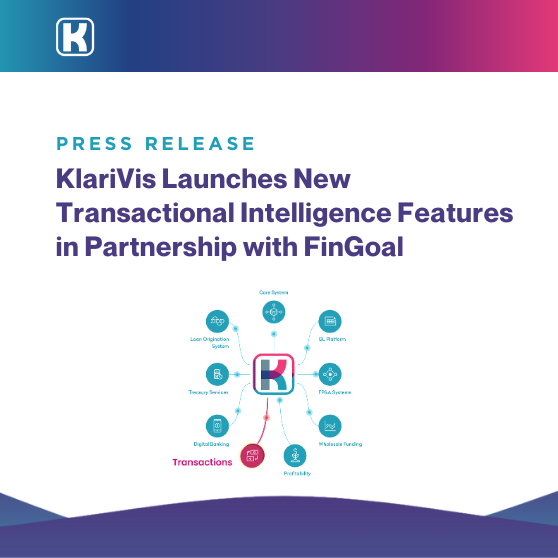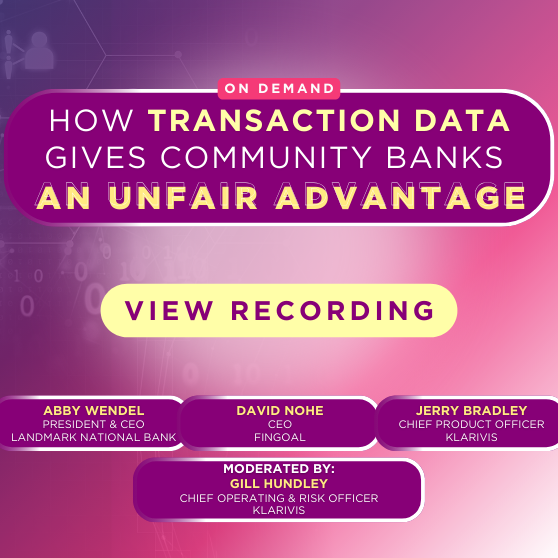The browser you are using is not supported. Please consider using a modern browser.
Article
Why Transactional Intelligence is Important for Banking Right Now
The KlariVis team couldn’t be prouder to introduce our new Transactional Intelligence suite to the banking community. Knowing the impact this will have for our clients, our product and engineering teams have worked diligently to hone these new tools, and now we’re ready to hand it over and see the incredible things they’ll be able to accomplish with it.
As is standard for a product launch, we’re working to create engaging ways to tell you more about Transactional Intelligence and what exactly it does. Yes, we can say it’s a powerful new suite of modules designed to help financial institutions uncover critical customer insights, optimize operations, and drive strategic growth…but what does that mean? What does this product do or tell you that you – financial services professionals — don’t already know?
Most banks have too much transaction data to know what to do with, spending the majority of their time processing rather than analyzing (assuming they have the capabilities to do so). With Transactional Intelligence, banks gain the opportunity to leverage the large amounts of transaction data they have as a strategic asset to drive personalized engagement and long-term loyalty.
“When an institution has over 1,000 different codes and hundreds of thousands of transactions happening daily or weekly, it’s incredibly difficult to boil anything down to a digestible manner,” Amy Kelley, Product Manager and key contributor to Transactional Intelligence at KlariVis, says. “At its core, that’s what Transactional Intelligence is designed to do — to make sense of any and all transactions and interactions your customers have.”
So, how can banks use these insights from transaction data in a real, impactful way? I’m so glad you asked. Let’s get into it.
What’s new about Transactional Intelligence?
The dashboards and reports included in Transactional Intelligence join over 650 prebuilt reports KlariVis provides to financial institutions of all sizes. With Transactional Intelligence, we’re diving into three new areas of the bank: external transactions, noninterest fees, and channel activity.
1. Customer Expansion Opportunities
Your bankers’ ability to strengthen and grow customer relationships begins with how much they can understand each customer’s financial habits and needs. Research from ConsumerAffairs reports that the average U.S. consumer has a total of 5.3 accounts across financial institutions. It’s not a question of if your customers are sending money elsewhere, it’s now how often and how much.
With the Customer Expansion Opportunities dashboard, banks gain a daily view of external transactions (how much, how often, and where), making it easier to spot trends and identify how a customer regularly utilizes their account, both at your institution and with other financial institutions.
Let’s use a common example: You’re informed of a group of commercial customers who are using Stripe as their payment provider. As a bank who provides their own merchant services alternative, a targeted offer for those customers with attractive pricing could help retain and deepen those relationships. And even if the offer is not taken, it signals to your customers that you are paying attention, that they matter to you. This isn’t just about new sales opportunities; it’s about recognizing what your customers are already doing and ensuring they have the best possible options and services available at your institution.
*NOTE: We’ve partnered with FinGoal to make our Customer Expansion Opportunities dashboards as clear and granular as possible. Transactions are analyzed and cleaned by FinGoal’s transaction enrichment technology, which populates as an easy-to-understand data point in the KlariVis platform.
 2. Noninterest Fee Income
2. Noninterest Fee Income
Understanding where and how much fee-based revenue occurs will be considered a strategic advantage in 2025 — we’re already seeing it in the conversations we’re having with bankers. This dashboard provides an in-depth look at where noninterest income is generated, helping institutions evaluate the impact of service fees, ATM charges, overdraft fees, and more.
With clear trends and data-backed insights, banks can determine whether certain fees are being underutilized or if they need to be adjusted to remain competitive. Not to mention, it provides complete visibility into fees across the bank — an increasingly important factor as regulatory scrutiny on banking fees continues to grow.
3. Channel Delivery
Customers are using multiple channels to conduct transactions — ACH, ATMs, mobile apps, point-of-sale transactions, and more. This dashboard helps financial institutions understand exactly how and where their customers are interacting with their bank.
This report identifies customers’ preferred transaction channel(s) so that banks can make more informed decisions about where to invest in technology, staffing, and customer service improvements. If mobile transactions are surging, for instance, it might make sense to prioritize digital banking enhancements during strategic planning. Or, if branch activity skyrockets in one location, banks can proactively staff it to keep up with demand.
Insights like these provide banks with the tools needed to analyze transaction activity and understand what exactly it indicates about customer behaviors. Every payment, withdrawal, or deposit is a clue about a customer’s needs, preferences, and potential next financial steps.
Taking immediate action.
We didn’t create an enterprise data platform to show you that we can make pretty graphs. Just like everything else we’ve created, the information Transactional Intelligence provides is designed to spur action. Understanding your data is only one part of the equation, and it’s not the meaningful half: It’s what you decide to do with your data that matters most.
Here are some immediate ways we’re seeing financial institutions use Transactional Intelligence to drive results:
- Call up a customer sending multiple outgoing payments to other financial institutions. This is a prime opportunity to market your own competitive products and rates. If there’s enough of a trend, create a new marketing effort and campaign.
- Identify businesses with consistent, high-volume transactions. Are you positive that these businesses know every service you provide for them? Is now a better time to offer certain ones? Don’t sit around waiting for the right time to reach out – know exactly when to do it.
- Analyze fee income trends and adjust pricing models. If a significant portion of noninterest income is coming from a particular service, consider optimizing the fee structure or bundling it with others for diversification.
- Use channel insights to refine digital banking strategies. We know that younger generations increasingly favor digital and online banking experiences. Channel Delivery insights pinpoint which digital services are gaining traction and where additional investment is needed to enhance customer engagement.
Transactional Intelligence is another proof-point in helping banks bridge the gap between data and decision-making. Kelley, who previously worked at FNCB Bank for over a decade, states, “This data isn’t just for observation — it’s a tool for action. We’re making it simple for banks to say ‘yes’ to proactively protecting customer relationships and optimizing products and services.”
Growth is top of mind for many bank executives this year. Stop leaving your customer relationships to guesswork and delayed reports; Transactional Intelligence gives you the clarity to act with confidence and the insights to drive meaningful results now.



